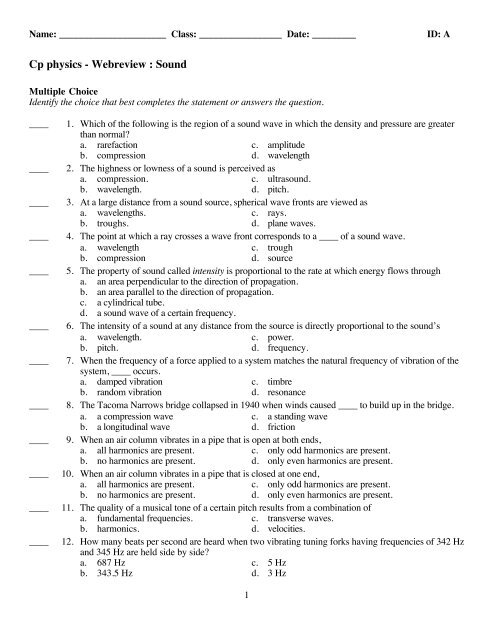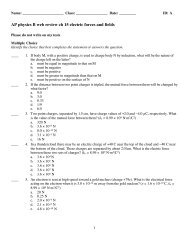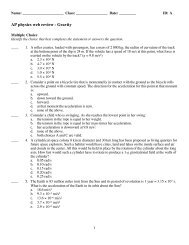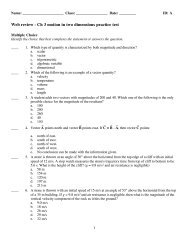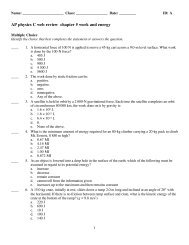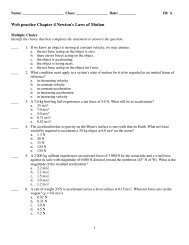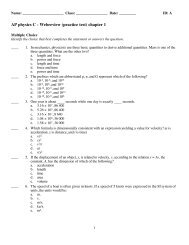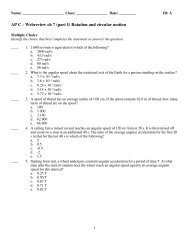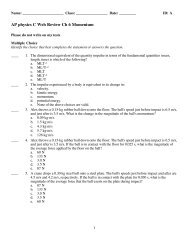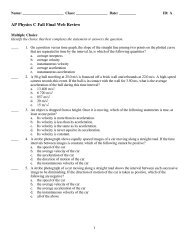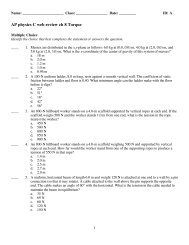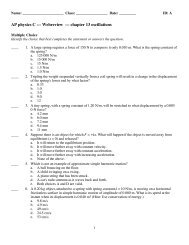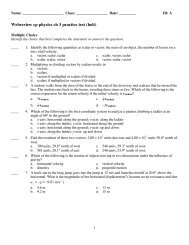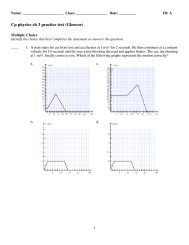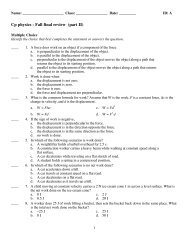Cp physics - Webreview Sound
Cp physics - Webreview : Sound - Planet Holloway
Cp physics - Webreview : Sound - Planet Holloway
Create successful ePaper yourself
Turn your PDF publications into a flip-book with our unique Google optimized e-Paper software.
Name: ______________________ Class: _________________ Date: _________<br />
ID: A<br />
<strong>Cp</strong> <strong>physics</strong> - <strong>Webreview</strong> : <strong>Sound</strong><br />
Multiple Choice<br />
Identify the choice that best completes the statement or answers the question.<br />
____<br />
____<br />
____<br />
____<br />
____<br />
____<br />
____<br />
____<br />
____<br />
____<br />
____<br />
____<br />
1. Which of the following is the region of a sound wave in which the density and pressure are greater<br />
than normal?<br />
a. rarefaction c. amplitude<br />
b. compression d. wavelength<br />
2. The highness or lowness of a sound is perceived as<br />
a. compression. c. ultrasound.<br />
b. wavelength. d. pitch.<br />
3. At a large distance from a sound source, spherical wave fronts are viewed as<br />
a. wavelengths. c. rays.<br />
b. troughs. d. plane waves.<br />
4. The point at which a ray crosses a wave front corresponds to a ____ of a sound wave.<br />
a. wavelength c. trough<br />
b. compression d. source<br />
5. The property of sound called intensity is proportional to the rate at which energy flows through<br />
a. an area perpendicular to the direction of propagation.<br />
b. an area parallel to the direction of propagation.<br />
c. a cylindrical tube.<br />
d. a sound wave of a certain frequency.<br />
6. The intensity of a sound at any distance from the source is directly proportional to the sound’s<br />
a. wavelength. c. power.<br />
b. pitch. d. frequency.<br />
7. When the frequency of a force applied to a system matches the natural frequency of vibration of the<br />
system, ____ occurs.<br />
a. damped vibration c. timbre<br />
b. random vibration d. resonance<br />
8. The Tacoma Narrows bridge collapsed in 1940 when winds caused ____ to build up in the bridge.<br />
a. a compression wave c. a standing wave<br />
b. a longitudinal wave d. friction<br />
9. When an air column vibrates in a pipe that is open at both ends,<br />
a. all harmonics are present. c. only odd harmonics are present.<br />
b. no harmonics are present. d. only even harmonics are present.<br />
10. When an air column vibrates in a pipe that is closed at one end,<br />
a. all harmonics are present. c. only odd harmonics are present.<br />
b. no harmonics are present. d. only even harmonics are present.<br />
11. The quality of a musical tone of a certain pitch results from a combination of<br />
a. fundamental frequencies. c. transverse waves.<br />
b. harmonics. d. velocities.<br />
12. How many beats per second are heard when two vibrating tuning forks having frequencies of 342 Hz<br />
and 345 Hz are held side by side?<br />
a. 687 Hz c. 5 Hz<br />
b. 343.5 Hz d. 3 Hz<br />
1
Name: ______________________<br />
ID: A<br />
____<br />
____<br />
13. How many beats per second are heard when two vibrating tuning forks having frequencies of 216 Hz<br />
and 224 Hz are held side by side?<br />
a. 6 Hz c. 9 Hz<br />
b. 8 Hz d. 3 Hz<br />
14. A vibrating guitar string emits a tone just as a 5.00 × 10 2 Hz tuning fork is struck. If five beats per<br />
second are heard, which of the following is a possible frequency of vibration of the string?<br />
a. 2500 Hz c. 605 Hz<br />
b. 1500 Hz d. 495 Hz<br />
Short Answer<br />
15. The region of a sound wave in which air molecules are pushed closer together is called a(n)<br />
____________________.<br />
16. Unlike a transverse wave on a rope, sound travels as a(n) ____________________ wave.<br />
17. Each trough of a sine wave used to represent a sound wave corresponds to a(n)<br />
____________________ of the sound wave.<br />
18. The ____________________ of a musical sound determines its pitch.<br />
19. What happens to pitch when the frequency of a sound wave increases?<br />
20. In general, does sound travel faster in a gas or in a solid? Explain.<br />
21. How is the speed of sound in air affected when the temperature increases?<br />
22. At a long distance from the source, spherical wave fronts can be treated as ____________________<br />
waves.<br />
23. Describe any changes in pitch of the sound a stationary observer hears from the siren of an<br />
ambulance as the ambulance passes the observer.<br />
24. Compare the pitch of a sound source moving toward a stationary observer with the pitch of the sound<br />
the observer hears. Explain how this phenomenon occurs.<br />
25. Under what conditions does sound resonance occur?<br />
26. What is the wavelength of the fundamental frequency of a tube with open ends and length L?<br />
Problem<br />
27. An organ tuner is comparing the fundamental pitch from a certain closed-end organ pipe that is 53.3<br />
cm long to the sound from an electronic signal generator set to a pitch of 165 Hz. The pipe is located<br />
in an environment in which the speed of sound is 343 m/s. How many beats per second will the organ<br />
tuner hear?<br />
2
ID: A<br />
<strong>Cp</strong> <strong>physics</strong> - <strong>Webreview</strong> : <strong>Sound</strong><br />
Answer Section<br />
MULTIPLE CHOICE<br />
1. B<br />
2. D<br />
3. D<br />
4. B<br />
5. A<br />
6. C<br />
7. D<br />
8. C<br />
9. A<br />
10. C<br />
11. B<br />
12. D<br />
13. B<br />
14. D<br />
SHORT ANSWER<br />
15. compression<br />
16. longitudinal<br />
17. rarefaction<br />
18. frequency<br />
19. The pitch rises.<br />
20. <strong>Sound</strong> travels faster in a solid than in a gas because the particles of a solid are closer together than<br />
those of a gas.<br />
21. The speed of sound in air increases as temperature increases.<br />
22. plane<br />
23. The apparent pitch of the sound drops as the ambulance passes.<br />
24. The stationary observer hears a sound with a higher pitch than the sound source is emitting. As the<br />
source moves, the wave fronts ahead of the source are pushed closer together than they would be if<br />
the source were stationary. Because the perceived wavelength is less while the wave speed is constant,<br />
the perceived frequency is greater, and thus the observed pitch is higher.<br />
25. Resonance occurs when the frequency of a force applied to an object is the same as the natural<br />
frequency of an object.<br />
26. 2L<br />
1
ID: A<br />
PROBLEM<br />
27. 4 beats/s<br />
Given<br />
v = 343 m/s<br />
L = 53.3 cm = 0.533 m<br />
f signal<br />
= 165 Hz<br />
Solution<br />
For a resonating tube closed at one end,<br />
f n<br />
= n v<br />
4L<br />
At the fundamental frequency, n = 1, so<br />
f 1<br />
=<br />
v<br />
4L = 343 m/s<br />
= 161 Hz<br />
4( 0.533 m) f signal<br />
= 165 Hz<br />
Beat frequency = f signal<br />
–f 1<br />
= 165 Hz–161 Hz = 4 beats/s<br />
2


